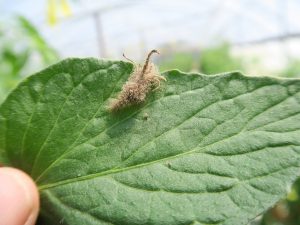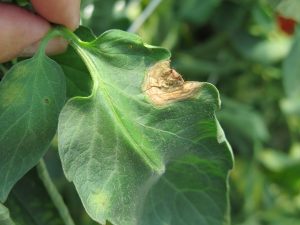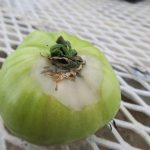The recent cool and cloudy weather has influenced conditions in the field as well as in greenhouses and high tunnels. I have observed more Botrytis gray mold of tomatoes in greenhouses this spring than usual. This is due in part to the weather. This article will discuss this disease on tomatoes and some management options.
Gray mold is caused by a fungus that attacks many types of vegetables and ornamentals. The fungus is not a strong pathogen and often starts on weakened or senescent tissue such as old flower petals. The gray mold fungus, Botrytis cinerea, may be a weak pathogen, but it is a good saprophyte, growing well on old crop debris and organic matter until a good plant host is available.
Figure 1 shows a tomato leaf on which a flower petal has fallen. Since the gray mold fungus is sporulating on the flower petal, there is a good chance that a lesion will soon start on the leaf. A gray mold lesion on a leaf is shown in figure 2 and a gray mold lesion on a tomato fruit is in figure 3. Note the flower petal on the top of the tomato fruit in figure 3.
Gray mold is favored by temperatures from 64° to 75°F and requires only high humidity (not leaf wetness) to become established. Our recent cool, cloudy weather fits these criteria. Greenhouses and high tunnels usually have higher humidity than adjacent fields.
Since the gray mold fungus can thrive on organic matter and crop debris, sanitation is key for management of this disease. Keep greenhouse floors clear of crop debris. Regularly remove tomato prunings from the greenhouse and surrounding area. Keep weeds to a minimum and don’t allow volunteer tomatoes from last year to grow. Just as dirty kitchens are associated with being unhealthy, I associate dirty, unkept greenhouses with disease.
As much as possible, keep greenhouses well ventilated. Weather permitting, vent the greenhouse in the evening to replace the humid air with relatively dry air from outside. Avoid the temptation to crowd as many tomato plants as possible into the greenhouse. Research has shown that spacing plants much closer than about 20 inches within the row and 5 feet between rows doesn’t increase yield and may reduce ventilation.
If possible, prune or sucker to improve ventilation. For determinate type tomatoes, ventilation can be improved with little chance of yield sacrifice by pruning the suckers from the plant bottom until the node below first flower cluster.
For more details on the management of foliar diseases of tomatoes in greenhouse, see “Tomato disease management in greenhouses” at https://www.extension.purdue.edu/extmedia/BP/BP-197-W.pdf or call Dan Egel for a hard copy.
Gray mold is known to be favored by low calcium levels in the plant. In particular, calcium to phosphorus levels of less than 2:1 may make the tomato plant more susceptible. In short, make sure your tomato plants have adequate nutrition.
Several fungicides are available to help manage gray mold of tomatoes in greenhouses or high tunnels. See the Midwest Vegetable Production Guide for Commercial Growers at mwveguide.org for more detailed information. Botran®, Fontelis®, Scala® and Switch® should all be effective against gray mold. Copper products such as copper hydroxide or copper sulfate will be less effective than the above products, but should offer some help. Oxidate® will help to sanitize the surface of the foliage of the gray mold fungal spores. However, Oxidate® will have no residue; therefore, Oxidate® will not protect against spores that land on foliage after the product has dried. Mancozeb products such as Manzate® and Dithane® are not labeled for gray mold. The fungicide Fracture® is a new product from FMC that is labeled for Botrytis gray mold, however I do not have any data or experience with this product yet. Fracture® and Oxidate® may be acceptable in organically managed systems. Many products with copper as an active ingredient may also be acceptable in organic systems. Note that only products allowed for greenhouse use are discussed here.
When should one make the decision to apply fungicides? Growers may make the decision to spray if the weather has been cool and wet for an extended time. Greenhouses that have had little chance of ventilation with outside air are more likely to have gray mold problems. Additional factors that may favor a fungicide application is if the greenhouse has had gray mold problems in the past and if tomatoes have been grown after tomatoes for several years. The first application should be make at or shortly after first bloom.
The weather should become warmer and drier soon. With the change of weather, gray mold should become less of a factor. The above discussion, however, should help growers to understand the biology and management of this important disease.


